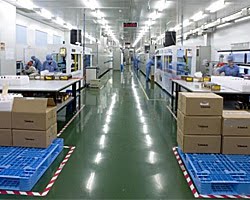A rebounding economy and growing pool of deep-pocketed investors could drive the U.S. solar industry to double its installations for a second year, but the capital costs for the clean energy systems remain huge.
The U.S. photovoltaic industry is coming off its best-ever year, with about 1 gigawatt in new panels installed. That is about equal to the capacity of a nuclear power reactor, or enough to power about 1 million homes, and many solar companies expect new installations to reach 2 GW this year.
Costs of the panels that turn sunlight into electricity continue to decline, although they still rely on subsidies to make them competitive with fossil fuel plants, a hurdle that makes many investors wary.
But the industry's shift toward ever-bigger solar power plants has attracted the interest of large investors.
"We've got more than enough money to finance as much solar as I can find," said John Anderson, senior managing director and the head of power and infrastructure at John Hancock Financial Services in Boston, which spent about $3.5 billion last year on power projects and infrastructure.
"I want to find places where I can invest $50 million or more," he said, citing such previous projects as the 14 megawatt Nellis Solar Plant in Nevada and 17 MW Greater Sandhill plant in Colorado.
Even the largest existing U.S. plant, Sempra Energy's 48 MW plant at Copper Mountain, Nevada, pales in comparison to planned facilities such as First Solar's 290 MW Agua Caliente plant in Arizona.
The rebounding U.S. economy is likely to lift power prices, making it easier to finance solar projects, but the industry would likely need to raise about $10 billion to reach the 1.6 GW mark that consultancy IHS Herold expects to be built in 2011.
SELL THE TAX BREAKS
The key tool that solar project developers have relied on for new plants is the tax equity market, in which developers sell the future tax benefits of the clean energy systems to a financial partner who uses them to reduce its own tax liability.
That market had thrived until the Wall Street collapse in 2008 that pushed Lehman Brothers into bankruptcy and drove insurer AIG out of the market in which both companies had been leading players.
Currently, US Bancorp, Wells Fargo, PNC, Morgan Stanley and Mitsubishi UFJ Financial Group's Union Bank are the main players in the tax equity market, although about another half-dozen banks also participate.
That group is not large enough to meet the demand from companies seeking to develop new solar projects.
"I'd say I get presented five legitimate transactions a week," said Darren Van't Hof, director of renewable energy investments for U.S. Bank in St. Louis, a unit of U.S. Bancorp. "Sometimes it's 10 to 20. Maybe only half of them get financed."
The bank has a portfolio of about $800 million of renewable assets and is the biggest investor in residential solar in the country, but it still sees the U.S. industry lagging behind its counterparts across the Atlantic.
"Domestic lenders are probably 10 years behind their European counterparts," he said. "This asset class demands a longer tenor, and domestic banks, and U.S. Bank is one of them, just don't like to go long on debt."
Lenders are growing more comfortable with solar technology, particularly because many of the projects built in recent years have yielded higher returns than originally expected, according to Eric Hafter, senior vice president of Sharp Solar Energy Solutions Group,
"One of the really exciting things that is happening is big money is starting to find solar," he said.
As the industry matures, so does the financing behind the projects, which are now shifting toward more traditional project finance issues, in which lenders syndicate the debt and sell it to several parties to fund projects.
"You will see a very healthy demand for project finance, structured finance -- 40 to 50 percent could very well be structured finance," said Chris Robine, CEO of SPG Solar, a solar systems installer based in Novato, California.
An estimated 12 gigawatts of projects have been announced for the United States, but that figure likely includes several that are based on electricity sales agreements that are too low to attract financing.
The offtake agreements, called power purchase agreements, or PPAs, are essential to lock in revenue streams from the power plants, and lenders will not consider projects that do not have a PPA in place.
"Projects are happening now, but I still think there is a lot more talk than there is actual development," said Lance Markowitz, manager of the leasing and asset finance division at Union Bank in Los Angeles.
SOURCE: http://www.reuters.com/article/2011/03/03/us-solar-financing-idUSTRE7227AW20110303


No comments:
Post a Comment